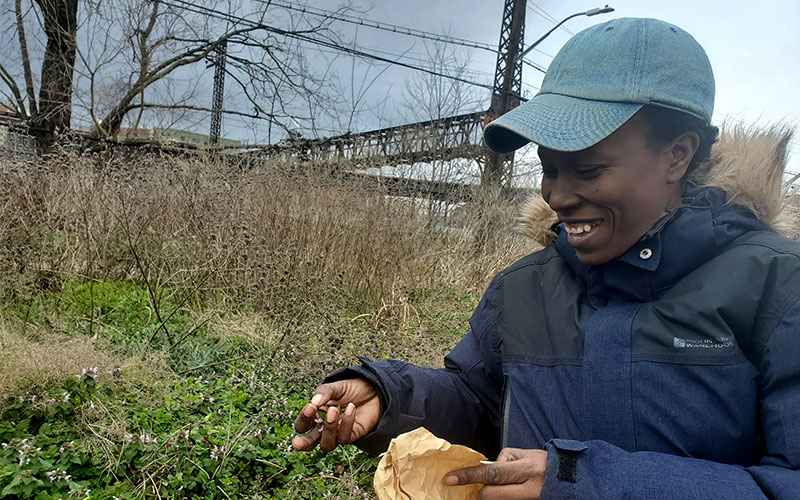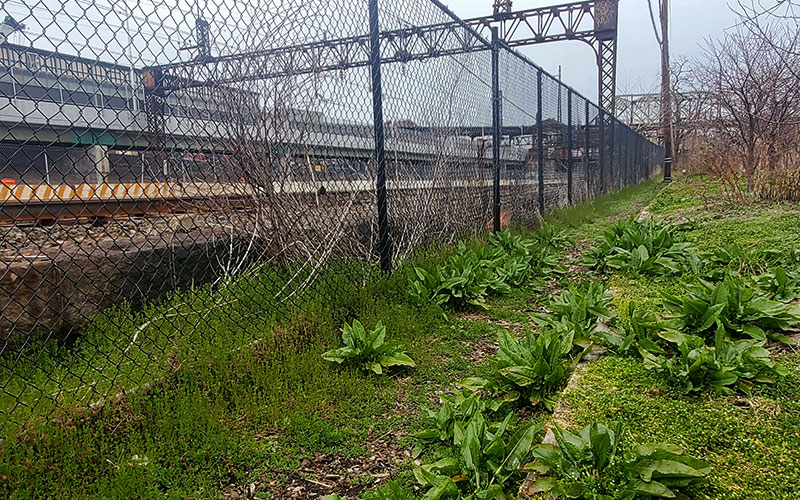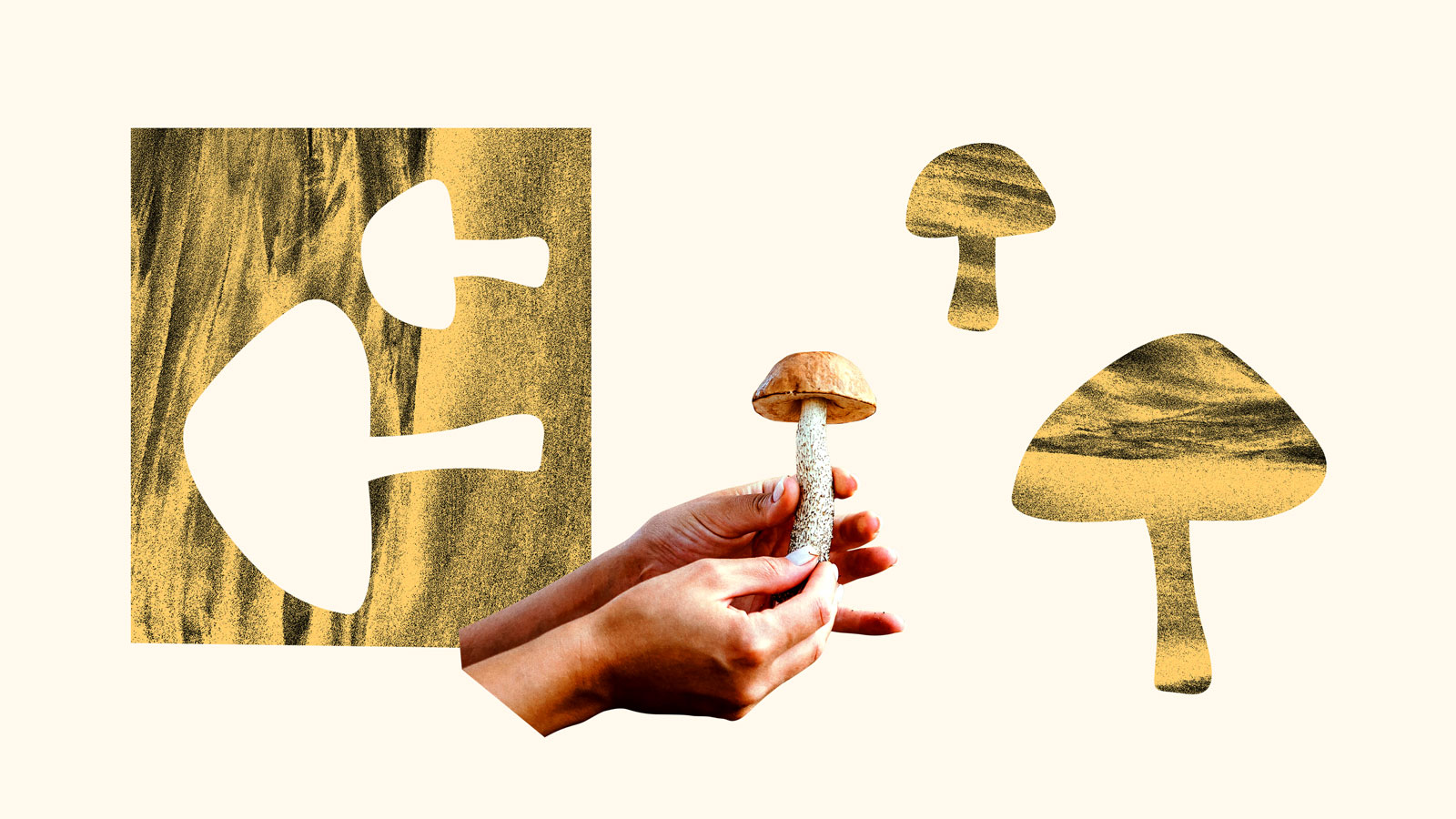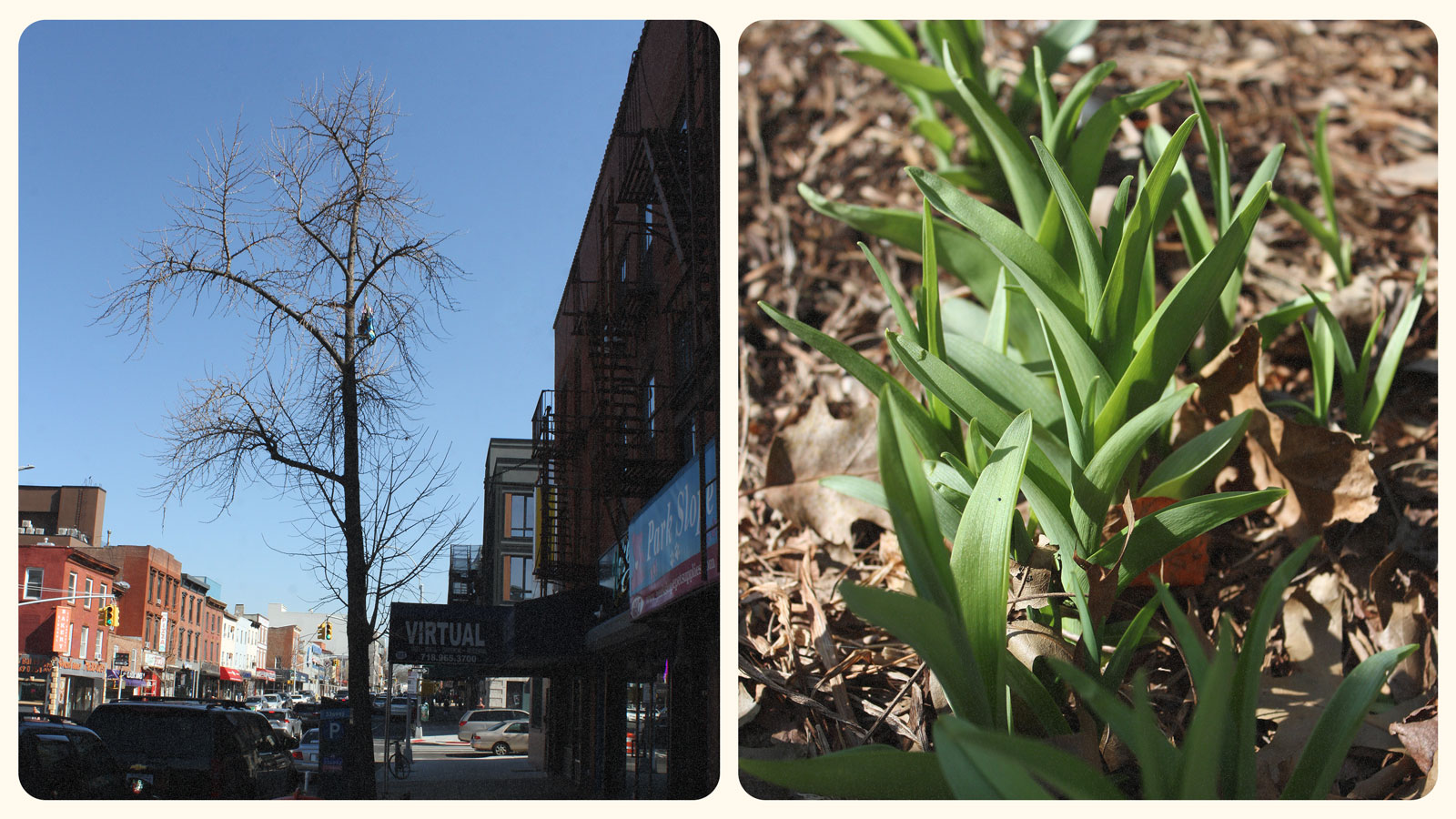This story is part of Fix’s Outdoors Issue, which explores the ways we build connections to nature, why those connections matter, and how equitable access to outside spaces is a vital climate solution.
Journei Bimwala is quick to spot the yellow, trumpetlike blooms in a meadow of mostly blue vervain, goldenrod, and mugwort along the western bank of the Bronx River. As she forages, she often scans her environment for unusual colors or breaks in familiar patterns, and she recognizes the newcomers as daffodils. She’d never seen them on this seven-acre corridor of land called Concrete Plant Park, one of just two city parks where foraging is allowed. Yet she isn’t surprised. “Wild plants move around, like people,” she says. “They’re very nomadic.”
These quiet changes in the landscape delight Bimwala, who gathers much of what she eats from green spaces like this one in New York City, tucked between a subway line and a highway. Foraging awakens a “childlike curiosity” to understand the overlooked wild foods and medicines there for the taking by anyone with a discerning eye. Of course, developing the expertise to see them takes patience, skill, and a willingness to heed nature’s cues. “It’s not just the ability to recognize a plant, identify it, and take it,” Bimwala says. “You actually have to build a relationship with your environment.”
[Read: Stories of outdoor adventures and connections that inspired climate and justice leaders.]
Bimwala forages daily, relying on the city’s edible margins to provide about 25 percent of what she eats and all of her medicine. Her pantry teems with fruits like persimmons, plums, and crab apples; greens like dandelion, chickweed, and purple dead nettle; and tinctures and salves made from pine pollen, elderberry, and witch hazel. “My whole house is overtaken by earth,” she says. Sometimes she forages simply for pleasure, clipping a flower early so she can observe “the whole budding-to-blooming in my house.”
“[Foraging] is not just the ability to recognize a plant, identify it, and take it. You actually have to build a relationship with your environment.”
— Journei Bimwala, foraging expert
Simply put, foraging is the act of identifying and gathering herbs, plants, mushrooms, berries, and other edibles. Although most often considered something done in a forest or meadow or other stereotypically “natural” locations, a growing number of people are taking up the activity in urban locales. It takes time to learn a landscape’s flora, a necessary prerequisite for foraging safely and environmentally, but many who embrace the practice find the benefits — including improved mental health and food security — well worth the effort.
For Bimwala, this practice provides fresh ingredients, from elderberry to sumac to wild chamomile, that otherwise can be costly or hard to find. No matter her economic circumstances or the state of the world, she can always rely on the local environment to help provide for her physical and mental well-being. A few hours foraging, using nothing more than scissors to harvest her bounty and a paper bag to carry it, always lifts her spirits. But nature can be a strict teacher. One lesson she’s learned: Miss the window of something blooming or fruiting, and she’s out of luck until next year. “The plants are teaching me not to be tardy,” she says.

It’s this emotional and physical connection to the natural world, often lost when living in a big city, that draws many people to foraging. “Sure, getting some free food out of a vacant lot is cute, but it’s a much deeper and more spiritual practice,” says Candace Thompson, who manages Stuyvesant Cove Park, the only other city park where foraging is allowed. They also explore foraging as a practice through their media project The Collaborative Urban Resilience Banquet. “Even on a shitty Bushwick sidewalk, [you can] look around at the way the seasons change,” Thompson says. They especially like to observe which wild plants bloom and how they differ from the previous year. “It has just opened up a whole new way of paying attention,” they say.
Throughout the pandemic, amid supply chain disruptions and collective unrest, Bimwala and fellow foragers have spent ever more time immersed in the activity. She encourages others to embrace the practice, hosting classes and individualized mentorship in foraging and herbalism. In that sense, she is teaching people to rely on themselves, and the Earth. “When everything goes wrong, nature is always around,” she said. “Nature is your fallback.”
Getting to know the edible world
Bimwala’s foraging journey began seven years ago when she was walking in Pelham Bay Park in the Bronx. She spotted a leafy green plant with soft-white hairs and a “beautiful, very distinguished scent,” and immediately had to know more. Bimwala snapped a photo and tumbled down a “Google rabbit hole” that led her to its name: mugwort.
Bimwala now considers mugwort — an abundant perennial with medicinal properties — her “first plant.” Whenever she encounters an unfamiliar plant, she relies on a similar process of snapping a photo and turning to the internet for help identifying it. The process can be slow, like learning a new language, but regional foraging guides, engaging online educational content from foragers like Alexis Nikole Nelson and Gordon Walker, and cookbooks like Marie Viljoen’s Forage, Harvest, Feast make things a bit easier.
After identifying the plant, Bimwala is careful to listen to her body, which helps her understand how to use it. “I start to document my own experience with the plant, so I will taste it in tea. I will taste it in a tincture. I will taste it in food and different variations, seeing how my body feels about the plant and how I’m reacting to it,” she says. Like foraging, it’s a process that requires a degree of trust in her senses, a skill that develops over time.
A location like the Bronx River Foodway in Concrete Plant Park is a good one to start foraging — a place where the practice is legal, none of the plants are sprayed with chemicals, and the soil is tested for residual pollutants. Online resources like Falling Fruit — a crowdsourced map of more than half a million foraging spots worldwide — and apps like Forager Diary or Wild Edibles can lead beginners and old hands alike to fruitful locations. Bimwala gives tours of the foodway, teaching people to identify plants, pick just what they need, and exercise caution, like testing the soil and learning the land’s history.

She leads me along a similar tour, beginning with a rose bush, its buds still tight like fists. “So many parts of the rose are edible,” muses Bimwala. For now, she’ll pick a few buds to distill as a tincture; later, she may gather the petals, careful to leave the buds so they can emerge as rose hips. “You have to be considerate of the plant’s cycle,” she says. “I’m not taking everything, killing the plant, and putting animals at risk of losing some of their nutrition.” Like a considerate housemate, she always leaves some of the plant for others.
Near the rose bush is an elder bush just beginning to reveal buds. Bimwala tends to gather them sparingly, leaving some to ripen into elderberries, a fruit that is popular (and pricey) because of its antioxidant qualities. A key to identifying the sought-after plant is looking for raised knobs along its smooth gray-brown bark. “If you touch [the bark], you can feel it,” says Bimwala. “If it doesn’t have it, then it is not elder.” She takes other precautions to avoid poison and contamination, like not picking close to the pathway, where animals urinate. Fruits with exterior skin, higher off the ground in a tree, tend to be the lowest risk.
Just beneath the elder bush, creeping plants spread out like a soft green blanket. “This is chickweed,” says Bimwala, pointing to its smooth, egg-shaped leaves. “Another one that I have to forage on the constant. It’s really a great edible. You can steam it, and you can eat it raw on a salad.” The chickweed is growing alongside cleavers, with straggling, sticky stems. Another favorite, she gathers it daily to blend into smoothies with cucumber, lemon, and ginger.
As we walk, we are greeted by wild patches of purple dead nettle’s low-hanging, fuzzy green leaves with purple tops and pink flowers. Bimwala encourages me to take handfuls because there is plenty of this so-called invasive weed, which she dries into a tea, to go around.
Bimwala doesn’t use the words invasive or native, a binary rooted in harmful human categories. She notes how some people consider dandelion an invasive weed when it appears in a lawn, but others happily buy dandelion root tea in health food stores. Many other so-called invasives, like chickweed and mugwort, are dense with nutritious and medicinal benefits — if more people only knew how to look for them.
Reclaiming a suppressed practice
As a best practice, Bimwala and other foragers are careful not to over-pick a plant that is scarce, but tend to not shy away from harvesting what is abundant. By understanding an ecosystem’s needs, foragers can act as stewards. As Thompson puts it, “We could be eating our ecosystem back into balance as a community,” an approach that requires foraging with biodiversity in mind. For instance, they point to how wild ramps have surged in popularity, harvested recklessly to a point of scarcity.
As an alternative, they recommend field garlic, also known as onion grass, loathed by some gardeners who consider it a stubborn weed. But Thompson says it’s a delicious, versatile food that works beautifully in pesto or pajeon, Korean pancakes typically made with scallions. It can also be infused in vinegar or oil, and the bulbs can be dried into an onion powder. “If you break the hollow stem and it smells like onions, it’s edible,” said Thompson. (If it doesn’t smell like onions, stay clear.) Once you become familiar with it, you’ll find field garlic everywhere.
By understanding an ecosystem’s needs, foragers can act as stewards.
Although every culture has a history of foraging and the practice was once commonplace throughout the United States, it remains illegal across broad swaths of the country, amid mounting pressure to change that. Many of these prohibitions date to emancipation, when anti-foraging laws targeted recently freed Black people, limiting their opportunities for self-sufficiency and economic independence. This differs from, say, Scotland, where a “right to roam” law gives people the right to forage, even on some portions of private property, for personal consumption.
For many foragers, this history makes their practice inherently political, a way of pushing against prohibitive, racist laws that continue to, as Thompson says, “strip people of their ability to find food for themselves outside of the capitalist system.” It’s this stepping outside of extractive economies that also draws Mo Wilde to the practice, which she refers to in her forthcoming book as “one of the last wild acts of defiance against the concrete world,” given that it doesn’t require a degree or money — just training one’s senses.
And for now, foraging largely remains an act of defiance against the law, too. Foragers would like to see the practice legalized and integrated into city parks. For instance, Bimwala points to how foragers could help public spaces by foraging plants typically managed by chemical sprays or weeding. She sees Concrete Plant Park’s food forest as a “testing ground” to show other cities how to design beautiful, edible parks, packed with food and medicine for those ready to learn the land.
But Bimwala also doesn’t want people to get so comfortable with food forests, like the bountiful corridor of the Bronx, that they begin to think of uncultivated nature as something to avoid. “Why are we making nature such a scary thing?” she asks. After all, with just a little time and diligence, anyone can see the world differently — and learn to spot wild yellow blooms in a familiar meadow.
Explore more from Fix’s Outdoors Issue:
- Finding strength, and a calling, in a brood of eaglets
- This educator designs curricula to make nature inclusive for all kids
- An Indigenous Bible translation reframes Christianity’s connection to nature




